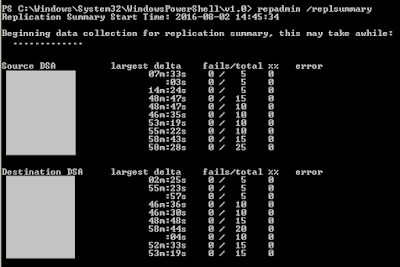Interpreting RepAdmin.exe /ReplSummary
One of the basic tasks you can do to verify Active Directory replication health is to run RepAdmin.exe /ReplSummary. The question becomes, what exactly do the results mean?
If you’re looking for a quick analysis, here it is. With no fails and all largest deltas less than 1 hour, you’re all good.
Now, for a more detailed look…
Total is the number of replication connections that a domain controller has with other domain controllers. The number of connections is probably higher than you expect because a separate connection is created for each Active Directory partition that’s being replicated. Most of the time you will have 5 per domain controller (domain, configuration, schema, DomainDnsZones, ForestDnsZones).
Fails is the number of connections that are not replicating properly. The number of fails should be zero.
Largest delta is where some of the confusion comes in. This is the longest period of time that a connection has not been used between two domain controllers. So, if a domain controller has one connection that has not replicated for 45 minutes and the others have replicated in less, then this value is 45 minutes. That is why this value tends to be high.
Your other thought is likely: How can it take up to an hour for replication to occur?
Within an AD site, all changes are replicated within seconds. However, there are partitions that do not change often. In particular, the schema partition probably changes only every few months. However, even when there are no changes, the connection for a partition will communicate occasionally to verify that it didn’t miss a change notification (polling). The default value for polling within a site is once per hour. That’s where the up to 60 minutes comes from.
You can change the time limit for polling within a site to twice per hour or four times per hour. That will reduce largest delta value, but it won’t really make a difference in the replication of changed AD data. You’re just triggering that polling to happen more often. And, almost all of the time, polling doesn’t trigger any data replication because replication notifications within the site would have already triggered it.
If you do want to change this value, it’s done in the Schedule for the NTDS Settings object in the AD site. It can also be modified for each connection individually, but it’s preferred to do it at the site level.
Between sites, the schedule on the site links will determine how often the polling happens. Most organizations that I work with have dropped the schedule down to every 15 minutes from the default of 180 minutes. If it were left at the default of 180 minutes then largest delta could range up to 180 minutes.
If you’re looking for a quick analysis, here it is. With no fails and all largest deltas less than 1 hour, you’re all good.
Now, for a more detailed look…
Total is the number of replication connections that a domain controller has with other domain controllers. The number of connections is probably higher than you expect because a separate connection is created for each Active Directory partition that’s being replicated. Most of the time you will have 5 per domain controller (domain, configuration, schema, DomainDnsZones, ForestDnsZones).
Fails is the number of connections that are not replicating properly. The number of fails should be zero.
Largest delta is where some of the confusion comes in. This is the longest period of time that a connection has not been used between two domain controllers. So, if a domain controller has one connection that has not replicated for 45 minutes and the others have replicated in less, then this value is 45 minutes. That is why this value tends to be high.
Your other thought is likely: How can it take up to an hour for replication to occur?
Within an AD site, all changes are replicated within seconds. However, there are partitions that do not change often. In particular, the schema partition probably changes only every few months. However, even when there are no changes, the connection for a partition will communicate occasionally to verify that it didn’t miss a change notification (polling). The default value for polling within a site is once per hour. That’s where the up to 60 minutes comes from.
You can change the time limit for polling within a site to twice per hour or four times per hour. That will reduce largest delta value, but it won’t really make a difference in the replication of changed AD data. You’re just triggering that polling to happen more often. And, almost all of the time, polling doesn’t trigger any data replication because replication notifications within the site would have already triggered it.
If you do want to change this value, it’s done in the Schedule for the NTDS Settings object in the AD site. It can also be modified for each connection individually, but it’s preferred to do it at the site level.
Between sites, the schedule on the site links will determine how often the polling happens. Most organizations that I work with have dropped the schedule down to every 15 minutes from the default of 180 minutes. If it were left at the default of 180 minutes then largest delta could range up to 180 minutes.


Comments
Post a Comment